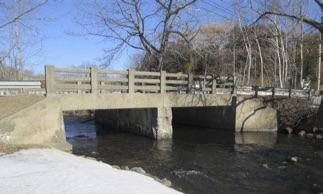Camden bridge closure highlights infrastructure deterioration
CAMDEN — In March 2018, Carmen Bombeke, senior engineer with Gartley and Dorsky, presented several ideas for replacing the deteriorating Rawson Ave. bridge in Camden, complete with estimated price tags that ranged from $433,000 to $505,000. The Select Board talked extensively with Bombeke at the meeting about structural problems with the aging bridge, and, according to March 20 board minutes, the “general consensus of the Board was for [Town Manager Audra] Caler-Bell to move forward and have a discussion with Maine Department of Transportation.”
Forward by one year and a month, and the DOT surprised the town April 12 with the announcement that it was shutting the bridge down by April 18 to all vehicular and pedestrian traffic.
“The bridge was constructed in 1935 and crosses the Megunticook River,” the DOT said, in its prepared closure announcement. “A team of bridge engineers evaluated the structure in March and determined that its advanced deterioration makes fixing it impractical. The bridge will be closed to all pedestrian and vehicle traffic until the structure is removed. Traffic can bypass the bridge by taking Ames Terrace to Route 105. The detour is less than a quarter of a mile.”
The bridge, however, is more integral to local traffic patterns than a quarter-mile detour, and there are many homes in the Millville neighborhood, along with a nearby middle school and food market.
But the short bridge is cracked, and following a heavy April 5 rainstorm, part of the bridge timber retaining wall collapsed.
A routine highway bridge inspection conducted March 18 by DOT personnel, and then apparently updated after April 5, paved the way for the DOT order that closed the bridge, permanently.
The Camden Select Board will hear an update April 23, when it meets next, from the town manager’s office.
See attached PDF for complete DOT report.
According to DOT spokesman Paul Merrill: “Discussions regarding the future of the bridge have been going on for years. Last year, we posted the bridge down to five tons.”
Nothing about the DOT was sudden, Merrill said.
“The condition of the slab reached a point where we felt the bridge was no longer safe for the traveling public,” he said. “In addition to the slab condition, the bridge is very scour critical. This means the bridge has a great risk for undermining.”
The DOT inspects the state’s federally-defined bridges on a 24-month cycle, regardless of ownership.
“When the condition of the bridge reaches serious, the bridge is placed on a 12-month cycle,” he said. “When bridges are closed, they are closed to all use. Also, closure means there will be no more inspections. It’s not safe to allow anyone on a bridge that is no longer being inspected.”
In March 2018, according to Select Board meeting minutes, “Bombeke presented a PowerPoint presentation of the study which reviewed the site inspection, evaluated bridge replacement options, produced concept designs and developed construction cost estimates for two proposed design options that would replace the bridge entirely and span a distance of 49 feet.”
Option 1 consisted of building a two-span concrete arch system, similar to the bridge installed next to Megunticook Market further up the stream. Its life expectancy was estimated to be 75 years, and the cost to be $505, 805.
Option 2 was a single-span steel truss bridge, similar to a rail road bridge style, with a life expectancy of 35 years for the truss. Its cost was estimated at $433, 560.
The DOT has apparently estimated bridge replacement cost to be $1 million, according to meeting minutes.
Other possibilities discussed at that March 2018 meeting included building just a footbridge and/or seeking grants for bridge replacement.
But meeting minutes said: “Caler-Bell felt that they [grants] would not be, and added that MDOT was responsible for the bridge and should pay 100%. Caler–Bell will open a discussion based on the study findings with MDOT and consult with them on solutions and funding as the cost is not in the range they believed. A final discussion on the condition of the bridge and allowing it to stand as a pedestrian way was held, Bombeke had not done any projections for this undertaking or the removal of support in the riverside upstream from the bridge. Bombeke suggested Caler-Bell get the projected costs from MDOT to close the road as part of the information needed to make future decisions and review costs.
“General consensus of the Board was for Caler-Bell to move forward and have a discussion with MDOT.”
The bridge, according to Bombeke’s memo, was built circa 1934.
“According to the original bridge plans, there was a defunct water wheel and tailrace that converged with the river immediately upstream of the bridge,” the memo said. “The relatively sharp curve in the river just upstream of the bridge is depicted in the 1934 site plan and appears similar to the existing riverway shape currently observed at the site. The existing bridge is a two-span cast-in-place concrete bridge supported on cast-in-place concrete abutments with a cast-in-place concrete support at midspan.”
The DOT remains firm in its decision, and it is now up to the town to consider the future of that neighborhood infrastructure.
“When bridges are closed, they are closed to all use,” said Merrill, on April 18. “Also, closure means there will be no more inspections. It’s not safe to allow anyone on a bridge that is no longer being inspected.”
Reach Editorial Director Lynda Clancy at lyndaclancy@penbaypilot.com; 207-706-6657

























